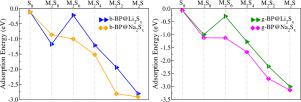当前位置:
X-MOL 学术
›
Appl. Surf. Sci.
›
论文详情
Our official English website, www.x-mol.net, welcomes your feedback! (Note: you will need to create a separate account there.)
Boron phosphide (BP) biphenylene and graphenylene networks as anode and anchoring materials for Li/Na-ion and Li/Na–S batteries
Applied Surface Science ( IF 6.7 ) Pub Date : 2024-04-15 , DOI: 10.1016/j.apsusc.2024.160096 Marwa Haouam , Yusuf Zuntu Abdullahi , Kamel Zanat , Fatih Ersan
Applied Surface Science ( IF 6.7 ) Pub Date : 2024-04-15 , DOI: 10.1016/j.apsusc.2024.160096 Marwa Haouam , Yusuf Zuntu Abdullahi , Kamel Zanat , Fatih Ersan

|
Using first-principles density functional theory (DFT) calculations, we evaluate the suitability of BP-biphenylene (b-BP) and BP-graphenylene (g-BP) monolayers for Li/Na-ion and Li/Na-S batteries. In our evaluations, we consider factors such as the adsorption energy () of b-BP and g-BP with adsorbed Li/Na adatoms, Li/Na polysulfides (Li/NaPSs) and clusters as well as the storage capacity and diffusion energy barrier () of Li/Na-ion on these surfaces. Our results indicate significantly higher Li/Na-ion storage capacities for b-BP at 700 mAh/g and g-BP at 550 mAh/g compared to typical graphite anode (372 mAh/g) and other carbon material (450 mAh/g). The values for Li/Na-ion were found to be 0.84/0.63 eV and 0.65/0.37 eV for b-BP and g-BP monolayers, respectively. The obtained values fall within the acceptable range of theoretically reported value for commercial TiO (0.4–1.0 eV) anode. The estimated open-circuit voltage (OCV) values fall within the acceptable range of 0.1–1.0 V for anode materials. Additionally, the values of Li/NaPSs and clusters on b-BP and g-BP surfaces are up to -2.80/-2.91 and -3.00/-3.13 eV, respectively, effectively preventing the unintended decomposition of Li/NaPSs. These findings highlight the potential of both b-BP and g-BP monolayers as promising anode materials for Li/Na-ion batteries as well as anchoring materials for Li/Na–S batteries, mitigating the shuttle effect.
中文翻译:

磷化硼 (BP) 联苯撑和石墨烯网络作为锂/钠离子和锂/钠硫电池的阳极和锚定材料
利用第一性原理密度泛函理论(DFT)计算,我们评估了 BP-联苯撑(b-BP)和 BP-石墨烯(g-BP)单层材料对于锂/钠离子和锂/钠硫电池的适用性。在我们的评估中,我们考虑了 b-BP 和 g-BP 吸附 Li/Na 原子、Li/Na 多硫化物 (Li/NaPSs) 和团簇的吸附能 () 以及存储容量和扩散能垒等因素这些表面上的 () Li/Na 离子。我们的结果表明,与典型石墨负极(372 mAh/g)和其他碳材料(450 mAh/g)相比,b-BP(700 mAh/g)和 g-BP(550 mAh/g)的锂/钠离子存储容量显着更高)。 b-BP 和 g-BP 单层的 Li/Na 离子值分别为 0.84/0.63 eV 和 0.65/0.37 eV。获得的值落在商业 TiO (0.4–1.0 eV) 阳极理论报告值的可接受范围内。阳极材料的估计开路电压 (OCV) 值落在可接受的 0.1–1.0 V 范围内。此外,b-BP和g-BP表面的Li/NaPSs和团簇值分别高达-2.80/-2.91和-3.00/-3.13 eV,有效防止Li/NaPSs的意外分解。这些发现凸显了 b-BP 和 g-BP 单层作为锂/钠离子电池负极材料以及锂/钠硫电池锚定材料的潜力,可减轻穿梭效应。
更新日期:2024-04-15
中文翻译:

磷化硼 (BP) 联苯撑和石墨烯网络作为锂/钠离子和锂/钠硫电池的阳极和锚定材料
利用第一性原理密度泛函理论(DFT)计算,我们评估了 BP-联苯撑(b-BP)和 BP-石墨烯(g-BP)单层材料对于锂/钠离子和锂/钠硫电池的适用性。在我们的评估中,我们考虑了 b-BP 和 g-BP 吸附 Li/Na 原子、Li/Na 多硫化物 (Li/NaPSs) 和团簇的吸附能 () 以及存储容量和扩散能垒等因素这些表面上的 () Li/Na 离子。我们的结果表明,与典型石墨负极(372 mAh/g)和其他碳材料(450 mAh/g)相比,b-BP(700 mAh/g)和 g-BP(550 mAh/g)的锂/钠离子存储容量显着更高)。 b-BP 和 g-BP 单层的 Li/Na 离子值分别为 0.84/0.63 eV 和 0.65/0.37 eV。获得的值落在商业 TiO (0.4–1.0 eV) 阳极理论报告值的可接受范围内。阳极材料的估计开路电压 (OCV) 值落在可接受的 0.1–1.0 V 范围内。此外,b-BP和g-BP表面的Li/NaPSs和团簇值分别高达-2.80/-2.91和-3.00/-3.13 eV,有效防止Li/NaPSs的意外分解。这些发现凸显了 b-BP 和 g-BP 单层作为锂/钠离子电池负极材料以及锂/钠硫电池锚定材料的潜力,可减轻穿梭效应。



























 京公网安备 11010802027423号
京公网安备 11010802027423号